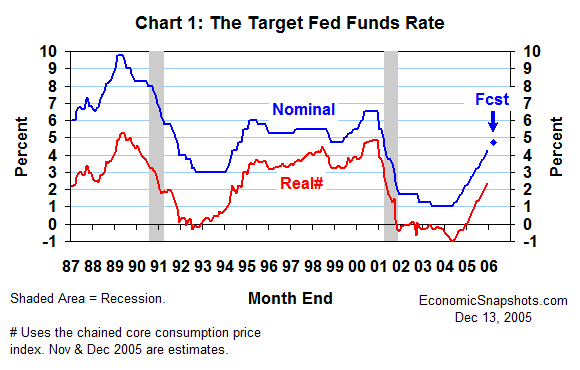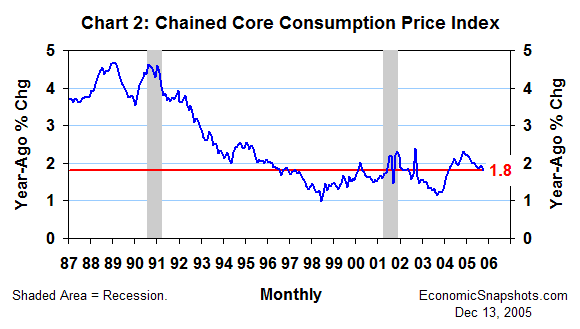
| Back to Index |
December 13, 2005 – The FOMC voted today to raise its Fed funds target by 25 basis points to 4.25%. This was the thirteenth 25 basis-point increase (Chart 1).

As noted in the FOMC’s post-meeting policy statement, “…some further measured policy firming is likely to be needed to keep the risks to the attainment of both sustainable economic growth and price stability roughly in balance.”
In a major rewrite of the longstanding boilerplate, the FOMC statement omitted its prior language describing monetary policy as “accommodative”. This may be a hint that the Fed funds target has now reached the FOMC’s “neutral” goal. Clearly, as far as the outlook for the next FOMC meeting is concerned, it doesn’t matter whether the Fed funds target is exactly “neutral” or not.
What does matter is the FOMC’s concern that, against the current backdrop of already “solid” real economic growth and “elevated energy prices”, any extra economic growth could add significantly to the economy’s inflation risks.
Reading between the lines, FOMC members seem to have been surprised by the lack of economic slowing since Hurricane Katrina struck in late August. As a result of this stronger-than-expected growth, the economy currently seems to have less spare capacity than FOMC members initially believed would be the case. This has added, in turn, to FOMC members’ fear that the hurricane-related surge in economic activity they expect to see “in the next couple of quarters” (according to the November 1 FOMC minutes) might strain the economy’s capacity limits hard enough to trigger some serious inflation trouble.
Thus, the December plan seems to be to continue the current tightening “program” until FOMC members have a better feel for the scale of these upside hurricane effects. This probably will require at least another three months of economic data.
As long as core inflation (excluding food and energy prices) stays “relatively low” and “longer-term inflation expectations remain contained” any future increases in the target Fed funds rate will probably continue in “measured” 25 basis point increments.
The chained price index for personal consumption expenditures excluding food and energy (the FOMC’s preferred inflation indicator) rose by 1.8% for the 12 months through October (Chart 2).

Given a steady inflation trend, the best guess here remains the same. The FOMC will probably raise its Fed funds target by 25 basis points at each of its next two policy meetings, bringing its Fed funds target to 4.75% by March next year.
Suzanne Rizzo